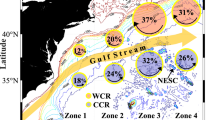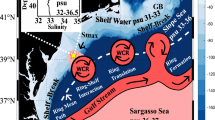Abstract
Gulf Stream warm-core rings form in the Slope Water between the North American continental shelf and the Gulf Stream by the separation of a north-extending meander1. The initial physical, chemical and biological properties of the core of these 100–200-km eddies are often similar to those of its parent water mass, the Sargasso Sea. A clockwise rotating remnant of the Gulf Stream circulates around the core with surface current speeds of 50–200 cm s−1. Although warm-core rings can slowly change over periods of months through interactions with the surrounding Slope Water, Gulf Stream meanders, continental slope, other rings, and the atmosphere, we have now discovered that major alterations to ring structure can occur during very short periods (2–5 days) when an interaction with the Gulf Stream is particularly intense. Such short-period interactions between a ring and the Gulf Stream are a major factor governing a ring's evolution.
This is a preview of subscription content, access via your institution
Access options
Subscribe to this journal
Receive 51 print issues and online access
$199.00 per year
only $3.90 per issue
Buy this article
- Purchase on Springer Link
- Instant access to full article PDF
Prices may be subject to local taxes which are calculated during checkout
Similar content being viewed by others
References
Saunders, P. M. Deep-Sea Res. 18, 1207–1219 (1971).
The Ocearnography Report EOS 63, (44), 834 (1982).
Worthington, L. V. On the North Atlantic Circulation (Johns Hopkins University Press, Baltimore, 1976).
Joyce, T. M., Schmitt, R. W. & Stalcup, M. C. Aust. J. mar. Freshwat. Res. 34, 515–524 (1983).
Brown, O. B., Olsen, D. B., Brown, J. W. & Evans, R. H. Aust. J. mar. Freshwat. Res. 34, 535–454 (1983).
Reid, R. O., Elliot, B. A. & Olsen, D. B. J. phys. Oceanogr. 11, 15–29 (1981).
Bray, N. & Fofonoff, N. P. J. phys. Oceanogr. 11, 30–47 (1981).
Olson, D. B. J. phys. Oceanogr. 10, 514–528 (1983).
Louis, J. P. & Smith, P. C. J. phys. Oceanogr. 12, 56–73 (1982).
Pedlosky, J. Geophysical Fluid Dynamics (Springer, Berlin, 1979).
Nafpaktitis, B. H. et al. Mem. Sears Fdn mar. Res. 1(7), 13–265 (1977).
Badcock, J. & Merrett, N. R. Prog. Oceanogr. 7, 3–58 (1976).
Badcock, J. & Merrett, N. R. in Oceanic Sound Scattering Prediction (eds Andersen, N. R. & Zahuranec, B. J.) 249–282 (Plenum, New York, 1977).
Ring Group Science 212, 1091–1100 (1981).
Okada, H. & Honjo, S. Deep-Sea Res. 20, 355–374 (1973).
Okada, H. & McIntyre, A. Micropaleontology 23, 1–55 (1977).
Reid, F. M. H. Micropaleontology 26, 151–176 (1980).
Author information
Authors and Affiliations
Rights and permissions
About this article
Cite this article
Joyce, T., Backus, R., Baker, K. et al. Rapid evolution of a Gulf Stream warm-core ring. Nature 308, 837–840 (1984). https://doi.org/10.1038/308837a0
Received:
Accepted:
Issue Date:
DOI: https://doi.org/10.1038/308837a0
Comments
By submitting a comment you agree to abide by our Terms and Community Guidelines. If you find something abusive or that does not comply with our terms or guidelines please flag it as inappropriate.



